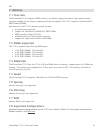
Dell
PowerEdge T110 II Technical Guide 20
Table 6 shows the shock and vibration specifications for the PowerEdge T110 II.
Shock and Vibration Specifications Table 6.
Maximum Vibration
Operating
0.26Grms at 5–350Hz for 15 minutes
Storage
1.88Grms at 10–500Hz for 15 minutes
Maximum Shock
Operating
One shock pulse in the positive z axis (one pulse
on each side of the system) of 31G for 2.6ms in
the operational orientation
Storage
Six consecutively executed shock pulses in the
positive and negative x, y, and z axes (one pulse
on each side of the system) of 71G for up to
2ms.
Six consecutively executed shock pulses in the
positive and negative x, y, and z axes (one pulse
on each side of the system) of Half-sine shock
71G for up to 2ms and square-wave shock 32G,
270 in/sec.
5.5 Maximum Input Amps
Maximum input current (high-output power supply):
9A @ 90 VAC
4.5A @ 180 VAC
5.6 Thermal
The thermal design of the PowerEdge T110 II reflects the following:
Closed-loop thermal fan speed control: The closed-loop thermal control method uses
feedback temperatures to dynamically determine proper fan speeds.
Comprehensive thermal management: The PowerEdge T110 II controls system cooling fan
speed based on several different responses from critical component sensors, such as processor
temperature, inlet ambient temperature, and system configurations. The thermal
management adjusts proper cooling for the system according to what the system really needs.
Optimized Ventilation: The T110 II chassis has a custom ventilation design for optimized air
flow path. Each component and peripheral is ensured sufficient air for cooling.
Environmental Specifications: The optimized thermal management makes the T110 II
reliable under a wide range of operating environments.
5.7 Acoustics
The acoustical design of the PowerEdge T110 II reflects the following:
Adherence to Dell’s high standards for sound quality: Sound quality is different from sound
power level and sound pressure level in that it describes how humans respond to annoyances
in sound, like whistles and hums. One of the sound quality metrics in the Dell specification is
prominence ratio of a tone, which is listed in Table 7.


















